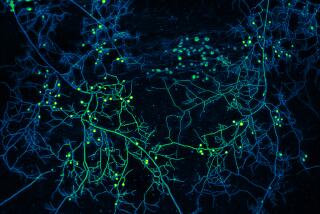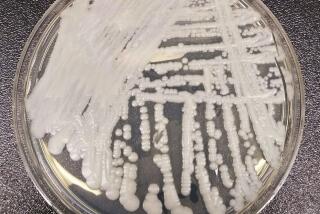Feet welcome multitude of fungi
- Share via
Here’s a scientific finding that may knock you off your feet: At least 80 types of fungi reside on a typical person’s heel, along with 60 between the toes and 40 on the toenail.
Altogether, the feet are home to more than 100 types of fungus, more than any other area of the human body, according to a study published Wednesday by the journal Nature. And that fungal fellowship is in constant motion as we walk through life.
It may sound icky, but many of the fungi on our skin serve a very useful purpose, said study leader Julie Segre, a geneticist at the National Human Genome Research Institute in Bethesda, Md.
“One of the major functions of healthy fungi is to prevent pathogenic fungi from adhering to our skin,” where they can cause athlete’s foot, plantar warts and stubborn toenail infections, she said. “There is something about toenails that fungi just love.”
Segre is at the forefront of research on the human microbiome — the collection of microscopic bacteria, viruses, fungi and mites that live in or on our bodies. The work increasingly shows that a thriving microbiome is essential to our health by helping us digest our food, fight disease and generally keep our systems in good working order.
In previous studies, Segre and her colleagues from various branches of the National Institutes of Health conducted a genetic analysis of bacteria that populate the different regions of our skin. This time, they turned their attention to fungi.
Dr. Heidi H. Kong, a dermatologist at the National Cancer Institute in Bethesda, recruited 10 healthy volunteers for the study. Using a sponge swab, she swiped 13 regions of each volunteer’s body, including the scalp, forehead, chest, forearms, nostrils, heel and the skin between the toes. She also clipped the subjects’ toenails.
Kong dipped the samples in a solution to remove the fungi and bacteria, which she then handed off to Segre.
Collecting DNA from fungi is more complicated than collecting it from bacteria, Segre said. Fungi have thicker cell walls, so more effort is required to break them down and release their genetic material.
Segre and members of her research team put tiny stainless steel beads and detergents in the solution and heated it up to 131 degrees Fahrenheit. That broke the cell walls, releasing the fungal DNA. The samples were fed into a gene-sequencing instrument.
The results revealed that an individual’s fungal biome looks very different from place to place. The forearms had between 18 and 23 types of fungi; sites like the forehead and chest had between two and 10.
But the feet stood out, with the most variety from heel to toe. Among the denizens were Saccharomyces, the kind of yeast that ferments bread and beer; Penicillium, which is used to make penicillin; and Malassezia, which can cause dandruff.
The findings also showed that our feet are like a bustling fungi hotel, with different types moving in and out at a fast clip.
When six of the 10 volunteers returned after one to three months for further swabbing, only 30% to 40% of the fungi on the feet had remained the same, the researchers found.
Segre said she doesn’t know why the fungal community on our feet is so diverse and unstable, but she has a few ideas. For starters, while skin temperature on our core remains a pretty stable 92.3 degrees, the temperature of our feet fluctuates wildly. Cold feet may be hospitable to some strains of fungi, while hot feet may be more attractive to others.
Since they’re so close to the ground, our feet are probably also exposed to more fungal diversity than other parts of our body.
And there’s one more thing: “People are fastidious about washing everything off their hands, but people don’t really specifically wash their feet,” Segre said. “For many people, standing in the shower seems good enough.”
Elizabeth Grice, an assistant professor of dermatology at the University of Pennsylvania who studies the microbes that live on skin, said researchers are just beginning to get their feet wet when it comes to understanding the fungus among us.
“There have been studies that look at the fungi in the gut, but we had no idea prior to this about what fungi was like on the skin,” said Grice, who wasn’t involved with the Nature study. “This really brings a different aspect of the microbiome to light. It is important to start thinking of the microbiome as many different organisms instead of just bacteria.”
Segre’s research may help scientists find ways to get rid of the unwanted types of fungi that live on our feet, like the ones that cause athlete’s foot. Fungal foot diseases are often treated with antifungal medications that attack all fungi indiscriminately, both good and bad. If scientists knew more about the specific types that cause problems, they could develop more-targeted treatments.
After doing this study, Segre says, she believes there is value in limiting the opportunities to expose our feet to new fungi.
“Really, wear flip-flops in the gym locker room,” she said.







